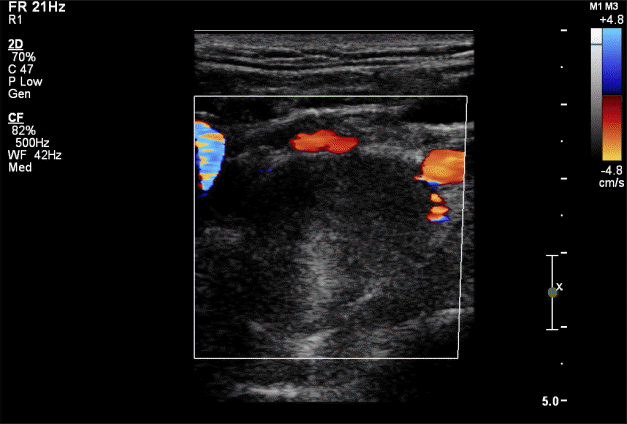경부 신경집종(schwannoma)에서 보이는 초음파검사 소견
Schwannoma Diagnosed with Duplex Ultrasonography
Article information
Abstract
경부에 발생되는 종물에 대한 검사로서 초음파검사의 유용성은 날로 높아져 가고 있다. 초음파검사는 검사자의 숙련도에 따라 그 진단율의 차이가 많이 있기에 높은 정확도를 보이기 위해서는 질병에 대한 특성을 이해하고 검사상의 특징을 숙지하여 함이 필요하겠다.
Trans Abstract
Palpable mass around the carotid artery are included aneurysm, pseudoaneurysm, carotid body tumor as a pulsating mass and schwannoma as a non-pulsatile mass. A schwannoma is a nerve sheath tumor and there was no specific identified cause. Most of the schwannoma in the neck is originated from 9th to 12th cranial nerve or sympathetic ganglion. Carotid body tumor shows hypervascularity compare to hypovascularity in schwannoma. We reported a case of schwannoma which could be diagnosed with duplex ultrasonography.
서 론
경동맥주위의 박동성 종물에는 동맥류, 가성동맥류 그리고 경동맥소체종양(carotid body tumor) 등이 있으며 이들 질환과 감별하여야 하는 비박동성 종물인 schwannoma(신경집종) 등이 있다. 신경집종은 신경을 둘러싸는 신경초에서 기인하는 신경초종양으로 원인은 밝혀져 있지 않다. 경부에 발생하는 대부분의 신경집종은 9-12번 뇌신경 또는 경부 교감신경절에서 기인한다[1-3]. 경동맥소체종양은 혈관과다성(hypervascularity) 소견을 보이는 반면 신경집종은 혈관과소성(hypovascularity)을 보이는 특징이 있다. 저자들은 경부 신경집종에서 보이는 혈관초음파검사의 특징적인 소견을 보고하고자 한다.
증 례
환자: 40세 남자
현병력: 좌측 경부에 비박동성 종물을 주소로 내원하였다. 약 3개월 전부터 간헐적인 어지러움증이 있었다. 목부위 통증은 호소하지 않았다. 과거력상 고혈압, 당뇨는 없었으며, 전신적인 특이증상은 없었다. 혈압은 132/92 mmHg이며, 맥박과 호흡 및 체온 등은 정상이었다.
영상검사 소견: 자기공명영상 및 자기공명혈관조영(magnetic resonance imaging, magnetic resonance angiography)에서 뇌실질에 비정상 병변은 보이지 않으며 두개강내 큰 혈관에 특이 병변은 없었으며, 좌측 경부에 약 2.5 cm × 4 cm 종괴가 보였다(Fig. 1). 컴퓨터단층혈관조영(computed tomography angiography)에서 좌측 외경동맥을 전외측으로 밀어 벌어지게 하는 상하로 길쭉한 모양의 종물이 관찰되었다(Fig. 2). L9-3 MHz 선형 탐촉자를 이용한 혈관 초음파검사상 흑백영상에서 경동맥 분기부의 후방으로 경계가 분명한 2.7 cm × 4.4 cm의 종괴가 관찰되었다(Fig. 3). 종괴는 내경동맥과 외경동맥을 외측으로 밀고 있었으나 두 동맥 사이를 벌리지는 않았다. 전체적으로는 균질한 에코를 보이지만 부분적인 저에코 액체저류로 여겨지는 부위와 함께 경도의 후방음향증강 소견을 동반하였다. 초음파의 종단 영상에서 종괴의 상•하 첨단부위가 가늘게 연장하면서 비후된 신경으로 연결되는 소견은 찾을 수 없었다. 컬러도플러에서 펄스반복주파수(pulse repetition frequency, PRF)를 낮추고 컬러게인(color gain)을 높혀 검사한 결과 종괴 내부에서 혈관과소성(hypovascularity) 소견을 보여 주었다(Fig. 4). 스펙트럴도플러영상에서 내경동맥은 정상혈류속도 범위와 저저항성 혈류파형을 유지하였으며, 외경동맥도 정상혈류인 고저항성 혈류파형을 유지하고 있었다(Fig. 5).

Magnetic resonance imaging findings. With high contrast-enhanced T2-TSE in coronal images in the left cervical approximately 2.5 cm × 4 cm tumor seems findings.

Computed tomography angiography imaging. (A) Cross-sectional images showing tumor (black arrow) seems to enhancement as part of the internal carotid artery inside (black arrow head: internal carotid artery, white arrow head: internal jugular vein). (B) The internal carotid artery due to a tumor (black arrow) is pushed outwards after. LT. ICA, left internal carotid Artery

Brightness ultrasound imaging. (A) There is 2.7 cm × 4.4 cm well defined margin mass with mild posterior acoustic enhancement in the carotid bifurcation Cross-sectional brightness ultrasound images. (B) There is partial hypoechoic lesion (arrow) in the upper area and it seem to localized partial liquid reservoir because there isn’t blood flow in the color Doppler imaging findings. Dist, distance.

Cross-sectional color ultrasound imaging. This is lower PRF and higher color gain image to exmainate slow blood flow image in the mass. Color that is seen blood flow in the tumor is not seen clearly and it seem the hypovascularity findings. PRF, pulse repetition frequency.

Spectral Doppler imaging. (A) This image show low resistance internal carotid artery waveform that is blunt peak systolic velocity and higher late diastolic velocity. (B) This image show high resistance external carotid artery waveform that is sharp peak systolic velocity and lower late diastolic velocity. PSV, peak systolic velocity; EDV, end diastolic velocity, RI, resistive index; ICA, internal carotid artery; ECA, external carotid artery.
이상의 검사 소견을 바탕으로 내경동맥과 분리되어 있는 비박동성 종물로 진단되어 경부 피부절개를 통한 수술적 제거술을 시행하였고 조직검사상 신경집종으로 확인되었다.
고 찰
경동맥에 발생되는 동맥류, 가성동맥류 그리고 경동맥소체종양과 경동맥과 분리되어 발생되는 신경집종 혹은 림파종 등에 대한 감별 진단은 매우 주요하다[4,5].
일반적으로 동맥류, 가성동맥류 그리고 경동맥소체종양 등은 박동성을 보이며 그 이외의 대부분의 종물은 비박동성을 보이므로 이학적 검사에서 구분이 가능하다.
일반적으로 박동성 종물에 대한 확진을 위해서는 동맥조영술이 요구된다. 이를 위해 과거에는 침습적 방법인 혈관조영술이 요구되었으나 의공 기술의 발달로 인하여 현재는 대부분 컴퓨터단층혈관조영술 및 혈관 초음파검사로 진단이 가능하다.
경동맥 동맥류의 동맥조영술 소견은 경동맥에서 대칭 또는 비대칭의 확장으로 보이며, 경동맥 가성동맥류의 동맥조영술 소견은 정상 경동맥혈관에 인접한 외부로 조영제가 유출되면서 조영되는 혈액주머니(낭)로 보인다. 경동맥 동맥류의 컬러도플러영상 특징으로는 태극 문양인 “Yin-Yang” 신호로 보여지는데 일정한 혈류속도로 주행하던 동맥혈류가 갑자기 넓어지는 동맥류 안에서는 와류로 변하면서 모자이크 패턴의 혈류로 바뀌면서 보여지기 때문이다. 스펙트럴도플러영상에서는 느린 혈류속도와 와류의 파형인 스펙트럴파형 기준선의 상•하 양측에서 불규칙한 파형으로 보여지게 된다.
경동맥주위에 발생하는 신경집종에 대한 동맥조영술 소견이 전형적으로 정립되지는 않았지만 경동맥 주행의 위치를 변형시키며 혈관과소성 종괴로 보인다. 또한 초음파검사 소견으로는 흑백영상에서 경계가 분명한 난형으로 내부 에코가 대부분이 균질한 고형 종괴로 경도의 후방음향증강을 동반한다. 이번 증례와 같이 내부에 부분적인 액체저류 에코가 있다면 혈관성 병변으로 혼돈할 여지가 있다. 비균질한 저에코부위의 혈관성 병변 여부를 확인하기 위해서는 컬러도플러영상검사가 도움이 된다. 느린 혈류속도의 혈류를 검사하기 위해서는 펄스반복주파수(PRF)를 낮추며 컬러게인(color gain)을 높여 느린 혈류의 민감도를 충분히 올려 검사한다. 종괴 내부에서 혈류로 보이는 컬러는 뚜렷이 보이지 않아 혈관과소성(hypovascularity) 소견으로 보이게 된다. 스펙트럴도플러검사영상에서는 각각의 경동맥에서 정상혈류파형과 혈류속도로 나타난다. 혈관과소성 종괴는 동맥과 직접적인 연결이 적기 때문에 주위 경동맥에서 동맥연결(shunting)을 시사하는 빠른 혈류속도, 높은 후기이완기 혈류속도 및 와류의 소견들은 동반하지 않는다. 따라서 총경동맥과 내경동맥에서는 저저항성 혈류 패턴을 유지하며 외경동맥에서는 정상 패턴인 저저항성 혈류 패턴을 유지하게 된다.